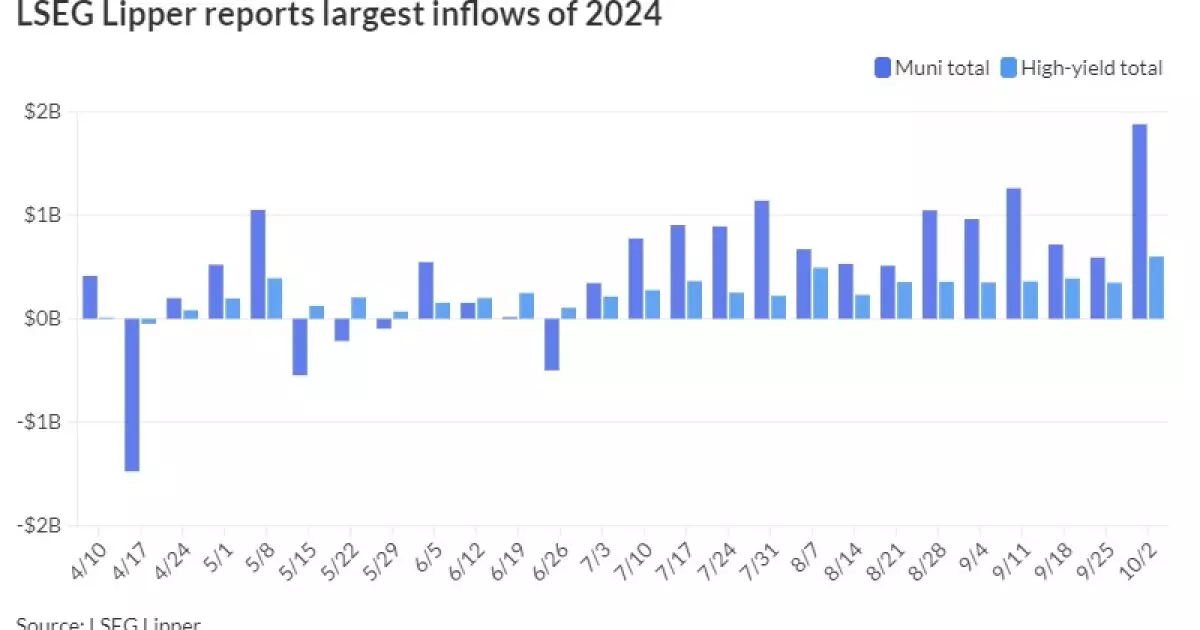In recent trading sessions, municipal bonds have encountered a challenging environment influenced by broader market dynamics, particularly as U.S. Treasuries experienced declines. This downturn is a microcosm of the impact that geopolitical tensions and contradictory economic indicators can have on fixed-income securities. Investors, eyeing the impending employment figures set for release on Friday, are demonstrating caution, particularly as equity markets show signs of weakness towards the day’s end. Within this context, the performance of municipal bonds has attracted significant interest, especially regarding the ongoing trends in inflows and yield adjustments in the face of a potentially volatile economic landscape.
Despite these pressures, municipal bond mutual funds have reported substantial inflows, recording nearly $1.9 billion during the last week. This figure underscores a remarkable trend as it represents the 14th consecutive week of inflows, marking the highest level observed in 2024 to date, according to LSEG data. Notably, this surge in investment confidence demonstrates robust support for municipal securities, even amid an uncertain economic backdrop.
The latest report from LSEG Lipper highlights a significant increase in fund inflows—from $592.1 million the previous week to nearly $1.9 billion—suggesting a changing sentiment among investors who are increasingly drawn to the perceived security of municipal bonds. Furthermore, the average inflow over the past four weeks has seen a rise to approximately $1.119 billion, indicating a consistent appetite for tax-exempt debt.
Digging deeper into the specifics, the inflows were primarily concentrated in long-term municipal funds, amounting to a positive influx of $1.6 billion. This trend points to the market’s preference for longer-duration investments, a sign that investors are willing to lock in yields over extended periods in anticipation of potential interest rate changes or economic recovery. J.P. Morgan’s studies further reinforce this sentiment, estimating substantial reinvestment opportunities likely to materialize in October, especially during the month’s initial days.
The appetite for rapid reinvestment has coincided with an environment of robust demand for various new issuances. This has led to oversubscriptions in numerous offerings and, subsequently, cuts to yield curves as investors seek to line their portfolios with high-quality municipal debt.
While the issuance of municipal bonds has surged by over 35% as of October, demand remains high, with many offerings experiencing significant oversubscription leading to yield repricing. Notably, the Bond Buyer has recorded a climb in the 30-day visible supply to $15.29 billion, further corroborating strong market fundamentals. On the trading front, municipal bonds have exhibited resilience against the backdrop of Treasury weakness, with yields across various durations adjusting in a bid to maintain competitive market positioning.
As per Refinitiv Municipal Market Data, the two-year municipal-to-Treasury ratio settled at 61%, with comparable readings across other maturities suggesting a consistent demand for municipal bonds compared to Treasuries. This adjustment in ratios reflects the relative attractiveness of municipal securities in this economic climate.
As the market turns its attention to the forthcoming employment data, various indicators have been hinting at possible increases in labor market activity. The recent ADP employment report signaled an increase in private payrolls, suggesting a potential upside risk as the market approaches the labor statistics release. J.P. Morgan’s projections have identified a non-farm payroll increase of about 125,000 for the month of September, although the variance from ADP findings could influence market sentiment and pricing in the immediate future.
Furthermore, the nuanced responses observed within the yield curve suggest a market grappling with mixed signals, particularly regarding the Federal Reserve’s future policy direction, especially as it pertains to interest rate management.
Municipal bonds are currently navigating through a complex landscape characterized by economic uncertainty, shifts in investor sentiment, and fluctuating yields. Despite facing pressures from U.S. Treasuries and external market factors, the sustained inflows into municipal bond mutual funds reaffirm the asset class’s resilience and attractiveness. As we observe ongoing macroeconomic developments, it will be critical for investors to remain attuned to market signals and actively manage their exposures to capitalize on potential growth while mitigating risks associated with volatility in the broader financial landscape.

